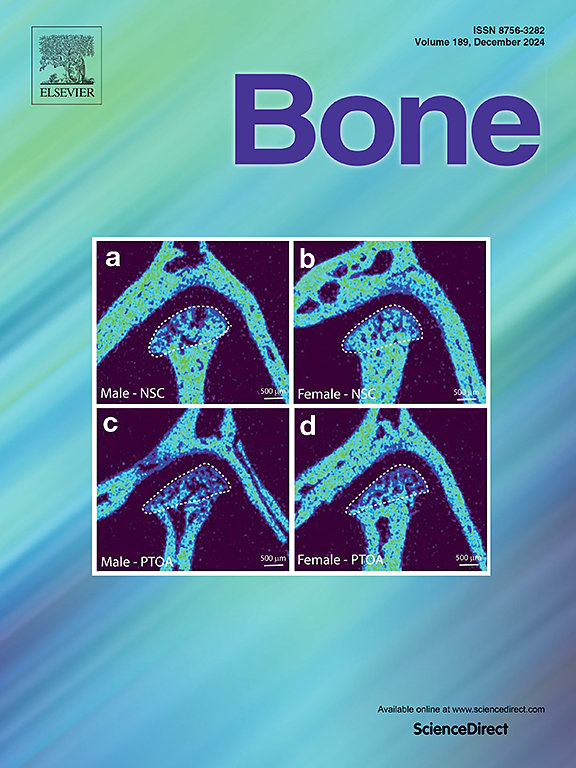Rebound hypercalcaemia timing is associated with cumulative weight-based denosumab dose for central giant cell granuloma treatment in children despite a dose weaning regimen
IF 3.5
2区 医学
Q2 ENDOCRINOLOGY & METABOLISM
引用次数: 0
Abstract
Central giant cell granulomas (CGCG) are locally destructive, non-neoplastic lesions that express receptor activator of nuclear factor-κB (RANK) and RANK ligand. Denosumab, a monoclonal antibody against RANK ligand, is licensed in skeletally mature patients, with less experience in children who are at risk of rebound hypercalcaemia.
We describe the response to denosumab in five skeletally immature children with CGCG. Denosumab was started aged 2.1 to 11.6 years, for 8 to 22 months, with a cumulative dose of 9.6 to 58.8 mg/kg. Three patients followed a weaning protocol (using reducing dose frequency and zoledronic acid).
Denosumab ossified all lesions. Three patients had subsequent surgery, and one had recurrence. All had rebound hypercalcaemia, 8.9–47 weeks (median 23.3 weeks) after the last treatment dose. Four presented with symptomatic hypercalcaemia and acute kidney injury. Cumulative denosumab treatment dose/kg positively correlated with (1) time to rebound after the last treatment dose (r2 = 0.94, p = 0.006); and (2) length of admission for hypercalcaemia treatment (r2 = 0.87, p = 0.02). All patients had increased bone mineral density and metaphyseal sclerosis that improved after stopping denosumab. One had a clavicular fracture at the intersection of normal and high-density bone.
We propose that rebound hypercalcaemia should be an anticipated consequence of stopping denosumab in skeletally immature patients and exists on a spectrum. A higher cumulative denosumab dose/kg increases the time to rebound hypercalcaemia and its severity. Further work is needed to establish the lowest dose and the shortest treatment duration to balance effective treatment with minimising side effects.
在儿童中枢性巨细胞肉芽肿治疗中,尽管有剂量断奶方案,但反弹高钙血症时间与基于体重的累积denosumab剂量相关
中央巨细胞肉芽肿(CGCG)是一种局部破坏性的非肿瘤性病变,表达核因子-κB受体激活因子(RANK)和RANK配体。Denosumab是一种针对RANK配体的单克隆抗体,已被批准用于骨骼成熟患者,但在有反跳性高钙血症风险的儿童中经验较少。我们描述了5名患有CGCG的骨骼不成熟儿童对denosumab的反应。Denosumab的起始年龄为2.1至11.6岁,疗程为8至22个月,累积剂量为9.6至58.8 mg/kg。3例患者遵循断奶方案(使用降低剂量频率和唑来膦酸)。Denosumab使所有病变骨化。3例患者接受了后续手术,1例复发。在最后一次治疗剂量后8.9-47周(中位23.3周),所有患者均出现反弹性高钙血症。4例出现症状性高钙血症和急性肾损伤。累积地诺单抗治疗剂量/kg与(1)末次治疗后反弹时间呈正相关(r2 = 0.94, p = 0.006);(2)高钙治疗的入院时间(r2 = 0.87, p = 0.02)。所有患者的骨密度和干骺端硬化均在停用denosumab后改善。其中一人在正常骨和高密度骨的交汇处锁骨骨折。我们建议,在骨骼不成熟的患者停用denosumab后,反弹性高钙血症应该是预期的结果,并且存在于谱上。较高的累积地诺单抗剂量/kg会增加高钙血症反弹的时间及其严重程度。需要进一步的工作来确定最低剂量和最短治疗时间,以平衡有效治疗和最小化副作用。
本文章由计算机程序翻译,如有差异,请以英文原文为准。
求助全文
约1分钟内获得全文
求助全文
来源期刊

Bone
医学-内分泌学与代谢
CiteScore
8.90
自引率
4.90%
发文量
264
审稿时长
30 days
期刊介绍:
BONE is an interdisciplinary forum for the rapid publication of original articles and reviews on basic, translational, and clinical aspects of bone and mineral metabolism. The Journal also encourages submissions related to interactions of bone with other organ systems, including cartilage, endocrine, muscle, fat, neural, vascular, gastrointestinal, hematopoietic, and immune systems. Particular attention is placed on the application of experimental studies to clinical practice.
 求助内容:
求助内容: 应助结果提醒方式:
应助结果提醒方式:


